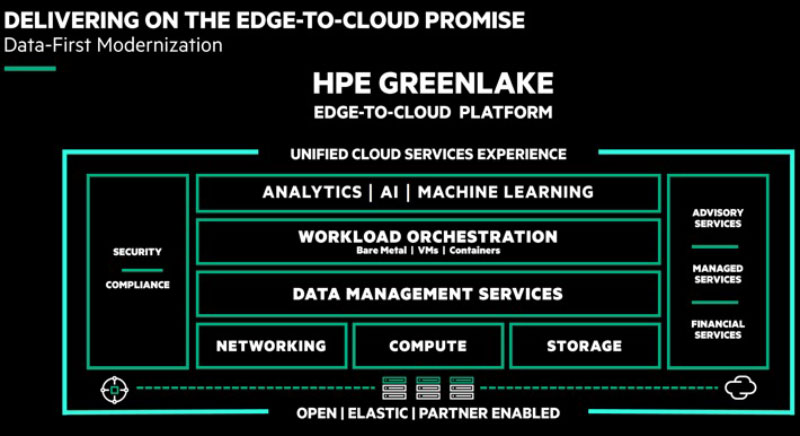What if you could wave a magic wand and be 20 times more likely to beat your competitors to market and 11 times more likely to beat your own revenue goals by 10% or more? What if you could eliminate data silos; simplify IT management and scalability; deliver rich, satisfying experiences to users and customers; and harness new levels of intelligence to accelerate decision velocity and deliver continuous steams of innovation?
All of this—and more—is not only possible but being accomplished by forward-thinking IT teams across all industries around the globe. None of these organizations has a magic wand. What they have in common is a new way of thinking about IT, one that recognizes that the only way to achieve true differentiation and digital transformation is by putting data front and center in every single aspect of the business.
This new approach to enterprise IT is best described by the concept of data-first modernization. Data-first modernization recognizes the reality that data, not technology infrastructure or the cloud, is the key to driving today’s IT operating model. The proof of its strategic value is in the success stories of companies that are ahead of the curve in putting data at the forefront of their businesses. According to research by Enterprise Strategy Group, data-first leaders are:
- 20 times more likely to beat their competitors to market with innovation, often by a significant amount of time
- 11 times more likely to beat revenue goals by 10% or more
- 5 times more likely to be highly resilient in terms of data loss
- 4 times more likely to have high job satisfaction among developers and data scientists
- 3 times more likely to prioritize applications over infrastructure1
What Is Data-First Modernization?
Data-first modernization means unlocking trapped legacy data and capturing data from edge to data center to cloud. It means ensuring that all data is connected and usable wherever it is located, leveraging analytics and intelligence to architect new processes. It means delivering rich experiences across billions of moments, accelerating decision velocity by cutting through organizational lethargy and “seeing around corners” to drive continuous innovation.
It requires a shift in focus for IT. Instead of modernizing IT by focusing on infrastructure or cloud, it prioritizes data as the foundation for digital transformation and differentiation. To make that shift, you need an enterprise IT platform that is data-centric from edge to cloud, allowing you to:
- Have visibility into every place where data is located
- Put analysis close to the data, including at the edge and in multiple clouds
- Free any data that is trapped in silos, whether in data centers, multiple clouds or edge locations
- Make all data accessible at digital speed, with frictionless movement across edge environments, data centers and clouds
Why Is It Necessary?
The prior wave of IT modernization—with a heavy emphasis on trying to migrate as much as possible to the public cloud—has proved to be lacking for any enterprise that has multigenerational infrastructures and applications. For many applications, there is no pressing need—and a huge potential expense and risk—in moving business-critical data to the public cloud. A data-first approach can help many businesses tackling these issues.
With more and more data being created at the edge, it is essential that edge data is not trapped in silos. You want analytics available as close as possible to where data is created in order to create differentiated experiences and strengthen application performance. Data-first modernization also supports security and business resilience across supply chains and enterprise ecosystems.
With a data-first approach, you eliminate silos and free trapped data, unifying data from multigeneration, multilocation applications and infrastructure. You can gain insights from data and applications from all locations, from edge to cloud to data centers. Analytics and intelligence engines are current, up to date, real time and inclusive. Unified service delivery with friction-free movement of data simplifies governance, sovereignty and lifecycle management.
How Do You Get Started?
Transforming to a data-first enterprise is challenging but eminently doable by leveraging the expertise, experience and proven best practices of key partners such as HPE GreenLake. With the right team, it is possible to break down the journey into identifiable steps that facilitate prioritization and allow for continual and measurable improvement. Having a common understanding of the role of data in your organization and having a common language to define priorities are important ways for IT leaders and teams to advance business initiatives.
The HPE GreenLake Edge-to-Cloud Platform provides a clear and consistent path to achieving data-first modernization. HPE GreenLake offers a unified cloud services experience that puts data at the center, with a stack based on analytics, AI and machine learning; workload orchestration and data management services; and an open, elastic, partner-enabled platform. The illustration below provides an overview of how HPE GreenLake delivers the edge-to cloud experience and can help drive a data-first modernization approach for your business.

Taking the Next Step
IT teams are under tremendous pressure to deliver on the promise of digital transformation. It is important to remember that digital transformation does not start with infrastructure or cloud; it starts with data. Organizations that can harness the power of all their data are already reaping huge competitive rewards. The gap between the data haves and data have-nots is growing due to the explosion of edge computing, internet of things, AI and other data-driven innovations.
The path to being a data-first company may not be as simple as waving a magic wand. But it can be accomplished over time with minimum disruption and maximum potential for true transformation for any organization ready to make the journey. For more information on how you can take advantage of data-first modernization across your enterprise IT platform, please visit HPE GreenLake and review the additional resources and articles on this special site.
1 “What Sets Today’s Data-First Leaders Apart From the Rest,” Enterprise Strategy Group, March 15, 2022

